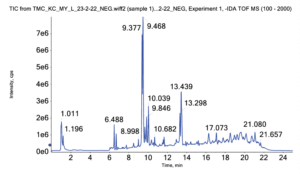DNA Genetics and UHPLC-Q-TOF-MS Analysis of Phytochemicals for Asparagus racemosus Roots
Advancing Medicinal Research with Asparagus racemosus: Insights Through Spectroscopy, Molecular Biology, and Biochemistry
The medicinal plant Asparagus racemosus, widely known as Shatavari, has been a cornerstone of traditional medicine, renowned for its diverse therapeutic applications. A recent study titled “DNA Genetics and UHPLC-Q-TOF-MS Analysis of Phytochemicals for Asparagus racemosus Roots” provides groundbreaking insights into its genetic makeup and phytochemical properties, offering a significant leap in conservation and pharmaceutical research. In this post, we explore the study’s findings, emphasizing their relevance to Spectroscopy, Molecular Biology, and Biochemistry.
For the complete study, refer to the full text or download the PDF version.
Introduction to Asparagus racemosus
Native to regions like India, Vietnam, and parts of Southeast Asia, Asparagus racemosus is increasingly endangered due to overharvesting. Known for its therapeutic properties in treating ailments like diabetes, diarrhea, bronchitis, and gastric issues, it holds immense potential for pharmaceutical innovation.
This research aims to address the twin challenges of conservation and pharmaceutical exploitation by leveraging tools from Spectroscopy, Molecular Biology, and Biochemistry.
 Figure 1: PCR product of DNA regions checked on 1% agarose gel. Abbreviations: 1, 2, 3, 4, 5, M: Marker 100bp plus DNA ladder, trnL-e/trnL-f
Figure 1: PCR product of DNA regions checked on 1% agarose gel. Abbreviations: 1, 2, 3, 4, 5, M: Marker 100bp plus DNA ladder, trnL-e/trnL-f
Phytochemical Analysis Through Spectroscopy
Spectroscopy, particularly Ultra-High-Performance Liquid Chromatography coupled with Quadrupole-Time-of-Flight Mass Spectrometry (UHPLC-Q-TOF-MS), plays a pivotal role in identifying the phytochemical composition of A. racemosus.
Key Findings:
- Flavonoids: Quercetin-3-glucuronide and Rutin, known for their antioxidant properties.
- Steroidal Saponins: Shatavarin I, IV, IX, Asparacoside, and Asparanin A, which contribute to anti-inflammatory and adaptogenic effects.
- Steroids: β-sitosterol and Daucosterol, beneficial for cholesterol regulation and immune modulation.
The chromatographic analysis revealed high-resolution mass spectra, enabling precise identification of these compounds. Such findings underscore the importance of Spectroscopy, Molecular Biology, and Biochemistry in advancing natural product research.
Genetic Insights Through Molecular Biology
DNA Barcoding and Genetic Identification
DNA barcoding was used to authenticate A. racemosus samples collected from five locations in Vietnam’s Gia Lai province. The trnL-e/trnL-f regions of chloroplast DNA were amplified using PCR and sequenced. Phylogenetic analysis revealed a genetic similarity of 98.5–99%, confirming the identity of the species.
Conservation Implications
Understanding the genetic diversity of A. racemosus aids in its conservation, allowing for targeted cultivation and protection strategies. Molecular tools ensure that genetic resources are preserved while enabling sustainable pharmaceutical applications.
Biochemistry: Unlocking Therapeutic Potential
The study highlights the rich biochemical profile of A. racemosus roots, emphasizing their pharmaceutical relevance.
Therapeutic Compounds Identified
- Antioxidants: Quercetin-3-glucuronide and Rutin combat oxidative stress, reducing the risk of chronic diseases.
- Anti-inflammatory Agents: Steroidal saponins like Shatavarin I and IV help manage inflammatory disorders.
- Adaptogens: Compounds such as Asparanin A support stress resistance and hormonal balance.
The findings reinforce the potential of Spectroscopy, Molecular Biology, and Biochemistry in isolating and characterizing bioactive compounds for drug development.
Applications in Pharmaceutical Research
The integration of phytochemical profiling and genetic analysis opens new avenues for pharmaceutical innovation:
- Drug Development: Bioactive compounds from A. racemosus can serve as templates for developing anti-inflammatory, antioxidant, and adaptogenic drugs.
- Quality Control: DNA barcoding ensures the authenticity of raw materials used in herbal formulations.
- Conservation Pharmacology: Preserving genetic and phytochemical diversity supports sustainable drug discovery.

Figure 2: TIC of HPLC-ESI-Q-TOF-MS NEG mode of water extract of wild A. racemosus roots
Figure 3: TIC of HPLC-ESI-Q-TOF-MS NEG mode of water extract of wild A. racemosus roots
For detailed methodologies, refer to the study’s full text.
Challenges and Future Directions
Challenges:
- Overharvesting: Rising demand threatens the natural populations of A. racemosus.
- Limited Sampling: Current genetic analyses cover a restricted geographical range, necessitating broader studies.
Future Research:
- Expanded Genetic Studies: Collecting samples from diverse regions to map global genetic diversity.
- Quantitative Phytochemical Analysis: Determining the concentration of bioactive compounds to standardize herbal products.
- Clinical Trials: Investigating the efficacy and safety of individual phytochemicals in treating specific ailments.
Conclusion
The integration of Spectroscopy, Molecular Biology, and Biochemistry in this study underscores the power of interdisciplinary approaches in medicinal research. By unraveling the genetic and phytochemical intricacies of Asparagus racemosus, the research not only contributes to its conservation but also paves the way for sustainable pharmaceutical development.
The findings reaffirm the role of advanced technologies in bridging traditional medicine with modern science, ensuring that nature’s bounty is preserved and utilized responsibly.
FAQs
What is the main focus of this study on Asparagus racemosus?
The study investigates the genetic diversity and phytochemical composition of Asparagus racemosus roots using DNA barcoding and UHPLC-Q-TOF-MS analysis, highlighting its medicinal potential.What key phytochemicals were identified in the study?
The study identified several bioactive compounds, including flavonoids (Quercetin-3-glucuronide, Rutin), steroidal saponins (Shatavarin I, IV, IX, Asparacoside, Asparanin A), and steroids (β-sitosterol, Daucosterol).How does DNA barcoding help in this research?
DNA barcoding was used to confirm the genetic identity of Asparagus racemosus samples, ensuring authenticity and aiding in conservation efforts by mapping genetic diversity.What are the pharmaceutical applications of this research?
The findings support the development of drugs with antioxidant, anti-inflammatory, and adaptogenic properties and ensure quality control of herbal formulations through genetic authentication.What technologies were employed in the study?
The research utilized advanced technologies like Ultra-High-Performance Liquid Chromatography coupled with Quadrupole-Time-of-Flight Mass Spectrometry (UHPLC-Q-TOF-MS) for phytochemical profiling and PCR-based DNA barcoding for genetic analysis.
